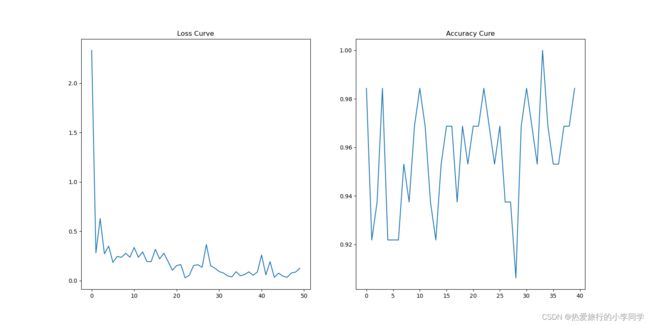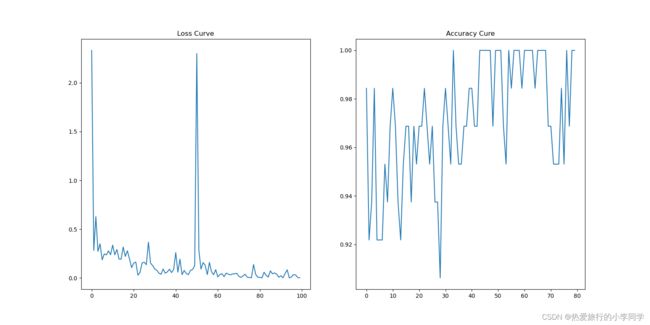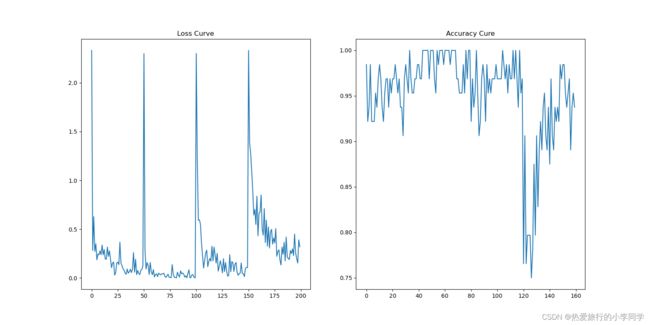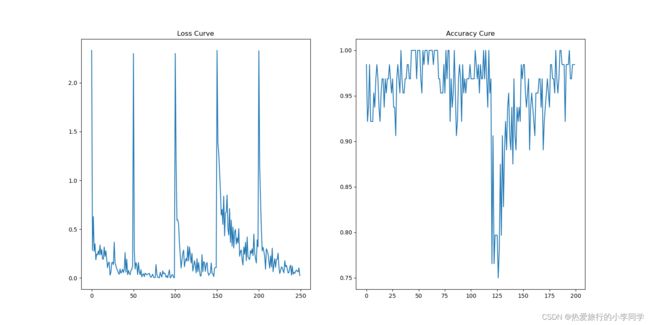深度学习笔记(2)——pytorch实现MNIST数据集分类(FNN、CNN、RNN、LSTM、GRU)
文章目录
- 0 前言
- 1 数据预处理
- 2 FNN(前馈神经网络)
- 3 CNN(卷积神经网络)
- 4 RNN(循环神经网络)
- 5 LSTM(长短期记忆网络)
- 6 GRU(门控循环单元)
- 7 完整代码
0 前言
快开学了,花了一个晚上时间复习深度学习基础代码,复习了最基础的MNIST手写数字识别数据集分类,使用FNN、CNN、RNN、LSTM、GRU实现。
1 数据预处理
import matplotlib.pyplot as plt
import torch
import time
import torch.nn.functional as F
from torch import nn, optim
from torchvision.datasets import MNIST
from torchvision.transforms import Compose, ToTensor, Normalize, Resize
from torch.utils.data import DataLoader
from sklearn.metrics import accuracy_score
# 超参数
BATCH_SIZE = 64 # 批次大小
EPOCHS = 5 # 迭代轮数
# 设备
DEVICE = 'cuda' if torch.cuda.is_available() else 'cpu'
# 数据转换
transformers = Compose(transforms=[ToTensor(), Normalize(mean=(0.1307,), std=(0.3081,))])
# 数据装载
dataset_train = MNIST(root=r'./data', train=True, download=False, transform=transformers)
dataset_test = MNIST(root=r'./data', train=False, download=False, transform=transformers)
dataloader_train = DataLoader(dataset=dataset_train, batch_size=BATCH_SIZE, shuffle=True)
dataloader_test = DataLoader(dataset=dataset_test, batch_size=BATCH_SIZE, shuffle=True)
2 FNN(前馈神经网络)
# FNN
class FNN(nn.Module):
# 定义网络结构
def __init__(self):
super(FNN, self).__init__()
self.layer1 = nn.Linear(28 * 28, 28) # 隐藏层
self.out = nn.Linear(28, 10) # 输出层
# 计算
def forward(self, x):
# 初始形状[batch_size, 1, 28, 28]
x = x.view(-1, 28 * 28)
x = torch.relu(self.layer1(x)) # 使用relu函数激活
x = self.out(x) # 输出层
return x
3 CNN(卷积神经网络)
# CNN
class CNN(nn.Module):
# 定义网络结构
def __init__(self):
super(CNN, self).__init__()
# 卷积层+池化层+卷积层
self.conv1 = nn.Conv2d(in_channels=1, out_channels=32, kernel_size=(3, 3), stride=(1, 1), padding=1)
self.conv2 = nn.Conv2d(in_channels=32, out_channels=64, kernel_size=(3, 3), stride=(1, 1), padding=1)
self.pool = nn.MaxPool2d(2, 2)
# dropout
self.dropout = nn.Dropout(p=0.25)
# 全连接层
self.fc1 = nn.Linear(64 * 7 * 7, 512)
self.fc2 = nn.Linear(512, 64)
self.fc3 = nn.Linear(64, 10)
# 计算
def forward(self, x):
# 初始形状[batch_size, 1, 28, 28]
x = self.pool(F.relu(self.conv1(x)))
x = self.dropout(x)
x = self.pool(F.relu(self.conv2(x)))
x = x.view(-1, 64 * 7 * 7)
x = F.relu(self.fc1(x))
x = F.relu(self.fc2(x))
x = self.fc3(x)
return x
4 RNN(循环神经网络)
# RNN
class RNN(nn.Module):
# 定义网络结构
def __init__(self):
super(RNN, self).__init__()
self.rnn = nn.RNN(input_size=28, hidden_size=64, num_layers=1, batch_first=True) # RNN
self.dropout = nn.Dropout(p=0.25)
self.out = nn.Linear(64, 10) # 全连接层
# 计算
def forward(self, x):
x = x.view(-1, 28, 28)
x = self.dropout(x)
r_out, _ = self.rnn(x, None)
x = self.out(r_out[:, -1, :])
return x
5 LSTM(长短期记忆网络)
# LSTM
class LSTM(nn.Module):
# 定义网络结构
def __init__(self):
super(LSTM, self).__init__()
self.lstm = nn.LSTM(input_size=28, hidden_size=64, num_layers=1, batch_first=True) # LSTM
self.dropout = nn.Dropout(p=0.25)
self.out = nn.Linear(64, 10) # 全连接层
# 计算
def forward(self, x):
x = x.view(-1, 28, 28) # [64, 28, 28]
x = self.dropout(x)
r_out, _ = self.lstm(x, None)
x = self.out(r_out[:, -1, :]) # [64, 10]
return x
6 GRU(门控循环单元)
class GRU(nn.Module):
# 定义网络结构
def __init__(self):
super(GRU, self).__init__()
self.gru = nn.GRU(input_size=28, hidden_size=64, num_layers=1, batch_first=True) # GRU
self.dropout = nn.Dropout(p=0.25)
self.out = nn.Linear(64, 10) # 全连接层
def forward(self, x):
x = x.view(-1, 28, 28)
x = self.dropout(x)
r_out, _ = self.gru(x, None)
x = self.out(r_out[:, -1, :])
return x
7 完整代码
综合评价:物种模型均能达到96%以上的准确率。CNN效果最好,FNN其次,RNN、LSTM、GRU波动较大。
代码中封装了(造轮子)几个函数,包括get_accuracy()、train()、test()、run()、initialize()
"""
MNIST数据集分类
尝试使用FNN、CNN、RNN、LSTM、GRU
"""
import matplotlib.pyplot as plt
import torch
import time
import torch.nn.functional as F
from torch import nn, optim
from torchvision.datasets import MNIST
from torchvision.transforms import Compose, ToTensor, Normalize, Resize
from torch.utils.data import DataLoader
from sklearn.metrics import accuracy_score
# 超参数
BATCH_SIZE = 64 # 批次大小
EPOCHS = 5 # 迭代轮数
# 设备
DEVICE = 'cuda' if torch.cuda.is_available() else 'cpu'
# 数据转换
transformers = Compose(transforms=[ToTensor(), Normalize(mean=(0.1307,), std=(0.3081,))])
# 数据装载
dataset_train = MNIST(root=r'./data', train=True, download=False, transform=transformers)
dataset_test = MNIST(root=r'./data', train=False, download=False, transform=transformers)
dataloader_train = DataLoader(dataset=dataset_train, batch_size=BATCH_SIZE, shuffle=True)
dataloader_test = DataLoader(dataset=dataset_test, batch_size=BATCH_SIZE, shuffle=True)
# FNN
class FNN(nn.Module):
# 定义网络结构
def __init__(self):
super(FNN, self).__init__()
self.layer1 = nn.Linear(28 * 28, 28) # 隐藏层
self.out = nn.Linear(28, 10) # 输出层
# 计算
def forward(self, x):
# 初始形状[batch_size, 1, 28, 28]
x = x.view(-1, 28 * 28)
x = torch.relu(self.layer1(x)) # 使用relu函数激活
x = self.out(x) # 输出层
return x
# CNN
class CNN(nn.Module):
# 定义网络结构
def __init__(self):
super(CNN, self).__init__()
# 卷积层+池化层+卷积层
self.conv1 = nn.Conv2d(in_channels=1, out_channels=32, kernel_size=(3, 3), stride=(1, 1), padding=1)
self.conv2 = nn.Conv2d(in_channels=32, out_channels=64, kernel_size=(3, 3), stride=(1, 1), padding=1)
self.pool = nn.MaxPool2d(2, 2)
# dropout
self.dropout = nn.Dropout(p=0.25)
# 全连接层
self.fc1 = nn.Linear(64 * 7 * 7, 512)
self.fc2 = nn.Linear(512, 64)
self.fc3 = nn.Linear(64, 10)
# 计算
def forward(self, x):
# 初始形状[batch_size, 1, 28, 28]
x = self.pool(F.relu(self.conv1(x)))
x = self.dropout(x)
x = self.pool(F.relu(self.conv2(x)))
x = x.view(-1, 64 * 7 * 7)
x = F.relu(self.fc1(x))
x = F.relu(self.fc2(x))
x = self.fc3(x)
return x
# RNN
class RNN(nn.Module):
# 定义网络结构
def __init__(self):
super(RNN, self).__init__()
self.rnn = nn.RNN(input_size=28, hidden_size=64, num_layers=1, batch_first=True) # RNN
self.dropout = nn.Dropout(p=0.25)
self.out = nn.Linear(64, 10) # 全连接层
# 计算
def forward(self, x):
x = x.view(-1, 28, 28)
x = self.dropout(x)
r_out, _ = self.rnn(x, None)
x = self.out(r_out[:, -1, :])
return x
# LSTM
class LSTM(nn.Module):
# 定义网络结构
def __init__(self):
super(LSTM, self).__init__()
self.lstm = nn.LSTM(input_size=28, hidden_size=64, num_layers=1, batch_first=True) # LSTM
self.dropout = nn.Dropout(p=0.25)
self.out = nn.Linear(64, 10) # 全连接层
# 计算
def forward(self, x):
x = x.view(-1, 28, 28) # [64, 28, 28]
x = self.dropout(x)
r_out, _ = self.lstm(x, None)
x = self.out(r_out[:, -1, :]) # [64, 10]
return x
class GRU(nn.Module):
# 定义网络结构
def __init__(self):
super(GRU, self).__init__()
self.gru = nn.GRU(input_size=28, hidden_size=64, num_layers=1, batch_first=True) # GRU
self.dropout = nn.Dropout(p=0.25)
self.out = nn.Linear(64, 10) # 全连接层
def forward(self, x):
x = x.view(-1, 28, 28)
x = self.dropout(x)
r_out, _ = self.gru(x, None)
x = self.out(r_out[:, -1, :])
return x
loss_func = nn.CrossEntropyLoss() # 交叉熵损失函数
# 记录损失值、准确率
loss_list, accuracy_list = [], []
# 计算准确率
def get_accuracy(model, datas, labels):
out = torch.softmax(model(datas), dim=1, dtype=torch.float32)
predictions = torch.max(input=out, dim=1)[1] # 最大值的索引
y_predict = predictions.to('cpu').data.numpy()
y_true = labels.to('cpu').data.numpy()
# accuracy = float(np.sum(y_predict == y_true)) / float(y_true.size) # 准确率
accuracy = accuracy_score(y_true, y_predict) # 准确率
return accuracy
# 训练
def train(model, optimizer, epoch):
model.train() # 模型训练
for i, (datas, labels) in enumerate(dataloader_train):
# 设备转换
datas = datas.to(DEVICE)
labels = labels.to(DEVICE)
# 计算结果
out = model(datas)
# 计算损失值
loss = loss_func(out, labels)
# 梯度清零
optimizer.zero_grad()
# 反向传播
loss.backward()
# 梯度更新
optimizer.step()
# 打印损失值
if i % 100 == 0:
print('Train Epoch:%d Loss:%0.6f' % (epoch, loss.item()))
loss_list.append(loss.item())
# 测试
def test(model, epoch):
model.eval()
with torch.no_grad():
for i, (datas, labels) in enumerate(dataloader_test):
# 设备转换
datas = datas.to(DEVICE)
labels = labels.to(DEVICE)
# 打印信息
if i % 20 == 0:
accuracy = get_accuracy(model, datas, labels)
print('Test Epoch:%d Accuracy:%0.6f' % (epoch, accuracy))
accuracy_list.append(accuracy)
# 运行
def run(model, optimizer, model_name):
t1 = time.time()
for epoch in range(EPOCHS):
train(model, optimizer, epoch)
test(model, epoch)
t2 = time.time()
print(f'共耗时{t2 - t1}秒')
# 绘制Loss曲线
plt.rcParams['figure.figsize'] = (16, 8)
plt.subplots(1, 2)
plt.subplot(1, 2, 1)
plt.plot(range(len(loss_list)), loss_list)
plt.title('Loss Curve')
plt.subplot(1, 2, 2)
plt.plot(range(len(accuracy_list)), accuracy_list)
plt.title('Accuracy Cure')
# plt.show()
plt.savefig(f'./figure/mnist_{model_name}.png')
def initialize(model, model_name):
print(f'Start {model_name}')
# 查看分配显存
print('GPU_Allocated:%d' % torch.cuda.memory_allocated())
# 优化器
optimizer = optim.Adam(params=model.parameters(), lr=0.001)
run(model, optimizer, model_name)
if __name__ == '__main__':
models = [FNN().to(DEVICE),
CNN().to(DEVICE),
LSTM().to(DEVICE),
RNN().to(DEVICE),
GRU().to(DEVICE)]
model_names = ['FNN', 'CNN', 'RNN', 'LSTM', 'GRU']
for model, model_name in zip(models, model_names):
initialize(model, model_name)
# 保存模型
torch.save(model.state_dict(), f'./model/mnist_{model_name}.pkl')
欢迎点赞收藏关注。
本人深度学习小白一枚,如有误,欢迎留言指正。




